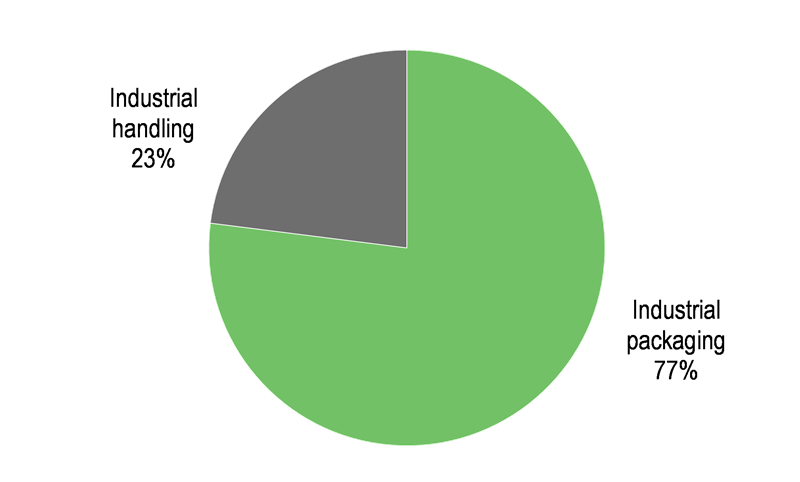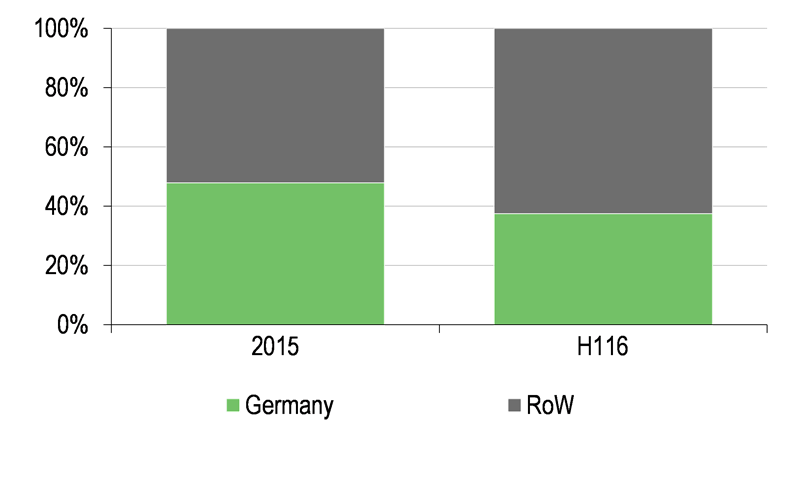Company description: Global leader; high-quality niche
Ringmetall is a leading manufacturer of specialist packaging solutions, with sales of around €100m, split about 40% in Germany and 60% elsewhere, the bulk of which is in the US. The company has two divisions:
■
Industrial packaging (77% of 2016 sales). Ringmetall manufactures industrial drum closure systems, lids and gaskets, locking rings, handles and accessories. The company’s most important end markets are within the food, chemicals/petrochemicals and pharmaceutical sectors as well as speciality industrial equipment and agriculture. Ringmetall’s products also have applications in other sensitive industries, such as nuclear and food. It is the global market leader in locking rings and has been active in this business for 60 years. In 2015, the company entered the US market through the acquisition of market-leading drum closure manufacturer Self Industries Inc.
■
Industrial handling (23% of 2016 sales). Ringmetall manufactures forklift components and specialist components for trucks and agricultural vehicles. These are niche components, such as speciality brakes and clutch pedals, lifting masts components as well as trailer systems and hydraulic brackets.
The company was founded in 1997 under the name of HPI and listed in 2007, which was followed by a rebranding to Ringmetall in 2015. Initially HPI was a private equity investor that held industrial manufacturing companies in its portfolio. After rebranding, Ringmetall became an industrial speciality company managing a number of industrial packaging subsidiaries as core businesses. The last capital increase was in May 2016, for €5m. The funding was used to increase the company’s stake in its Italian subsidiary S.G.T. to 80% from 51%. There is authorisation from the last AGM for additional capital raising of up to €3.4m up to 2021, and it seems logical to assume that this will be used to fund further acquisitions (see below).
Ringmetall is the global market leader in drum closure systems with market shares of about 70% globally and 80% in Europe and the US. Its position is underpinned by longstanding relationships with the three leading global drum manufacturers, Greif, Mauser and Schuetz. The fact that it tailors products to its customers underpins its strong position, which effectively provides a degree of barrier to entry. In addition, Ringmetall has other blue-chip clients, notably Linde, BASF, Novartis and John Deere. Industries handling hazardous products with high safety requirements (eg chemicals, pharmaceuticals, etc) make up most of the customer base.
The company is organised as a holding structure where Ringmetall Group provides strategy, finance and co-ordination from the centre and the regional subsidiaries operate largely independently. This allows for synergies and best practice sharing, yet adaptation to local markets and closeness to customers. Berger Group is the core of the industrial packaging segment and the origin of the industrial expertise in Germany. We assume there is a possibility that Ringmetall might contemplate a disposal of the Industrial Handling business, which as the company evolves more closely towards packaging, appears increasingly peripheral.
Exhibit 1: Group structure
|
Exhibit 2: Global businesses
|

|

|
Source: Eurostat, IFO, Bloomberg
|
|
Exhibit 1: Group structure
|

|
Source: Eurostat, IFO, Bloomberg
|
Exhibit 2: Global businesses
|

|
|
|
Germany 40% of sales; US boosted by acquisition in 2015
Ringmetall derives about 40% of its sales from Germany. The remainder is now heavily weighted to the US, but sales are global and include Europe and Asia. It has a well-diversified global base of production facilities, with eight sites in Europe, three in the US and two in Asia.
Exhibit 3: Revenues by segment, 2016
|
Exhibit 4: Revenues by geography
|

|

|
|
|
|
Exhibit 3: Revenues by segment, 2016
|

|
|
|
Exhibit 4: Revenues by geography
|

|
|
|
Strategy: Consolidate lead position and extend markets
Ringmetall’s strategy consists of two components:
■
Organic: Consolidation of its position as global market leader, with further market share growth in clamping rings and margin expansion for its core products.
■
M&A: Management has stated regularly and also at the 2016 results that it looks for acquisitions. Benefiting from management experience in private equity, we also expect growth to be augmented through the acquisition of adjacent products and capabilities in packaging.
Key growth regions: Asia and North America
Asia is the most important growth region, followed by the US. Ringmetall is looking to increase market share in China from currently low levels of around 20%, as there is strong demand growth for quality clamping systems as standards and regulations tighten. Given an already high market share in the US (c 80%), the scope for market share gains in the US is now more limited, although management still sees good prospects for organic growth. Europe is a stable region where the company is also dominant, which by nature largely limits organic growth prospects. However, there is scope to gain market share in Europe and the US. Process optimisation globally to enhance efficiency and provide economies of scale is a key component of the company’s margin expansion strategy.
Core strategy: High-quality product with close customer relationships
The core business is based on a strategy of high-quality products that fulfil strict safety requirements in industries that handle sensitive and/or dangerous substances. Within the total drum and closure system, the systems and components supplied by Ringmetall are characterised by a high content of technology and quality requirement, supplied at a low overall value in the greater context of the customer’s product, transport and packaging cost, meaning the price differential to cheaper yet higher-risk, lower-quality products is very small from the perspective of the buyer. Therefore, a price vs quality trade off very much favours Ringmetall’s product, which is further reinforced by UN certification. It is also worth noting that low-cost competitors in most instances cannot meet customers’ required quality standards, and additionally that shipping clamping rings is uneconomical due to the relatively low value and high transport cost. Ringmetall further has a competitive advantage through unique industrial know-how that enables the company to respond to very specific needs and thereby foster close relationships, if not customer dependency, in effect creating mutual dependency. Due to the wide range of product capabilities within closing systems, the company is a one-stop shop for a vast multitude of systems and components, which is another competitive advantage. Ringmetall is the preferred supplier to the three largest global drum manufacturers, which often specify Ringmetall to supply entire series of systems across a whole product range. Its manufacturing is increasingly highly automated and all of its robotics are developed in house. This further reinforces barriers to entry in terms of process IP and technology. Importantly, clamping rings tend to wear out after a few uses, which means there is regular replacement demand. For the aftermarket Ringmetall tends to be the default supplier, due to being already designed in and its strong customer relationships. Also, very importantly, because the drum, ring lid etc are certified, the customer needs to use Ringmetall’s systems to avoid the need to re-certify the entire system.
Acquisition-driven growth
Since inception, acquisition-derived growth has been a key aspect of the company’s development and continues to be so. In this process it acts as an industry consolidator, targeting complementary products and expansion of its distribution reach in order to accelerate market penetration. The company’s criteria for acquisitions include market leadership, profitability, scope for synergies and a short timeline to earnings accretion. In 2015, the company acquired US-based Self Industries Inc, the market-leading manufacturer of clamping rings in the US. This was the largest acquisition in Ringmetall’s history so far (purchase price not divulged) and has led to significant earnings accretion in 2016 (see below) as the integration was successfully completed.
A fragmented market and an increasing trend towards consolidation in the industry facilitate the company’s strategy. On occasions, Ringmetall is mandated by its clients, which on their part seek to secure certain supplier relationships, be it regional or otherwise, to acquire competitors or closely related businesses. We note, however, that its high market share limits growth potential in its core markets through acquisitions. We sense that management is very aware of this issue as the company is looking to grow into adjacent areas within industrial packaging, but also in heating or air conditioning where it may see scope in pipe connections. Additionally, the company pursues margin expansion through synergy benefits as it integrates new companies. It will most likely fund acquisitions through capital increases, which management has made clear would only occur to fund acquisitions and not for any other purposes.
Unsurprisingly, as a growth company, dividend payout is on a relatively low level, at least for the foreseeable future, even though management targets a reasonable dividend.


















